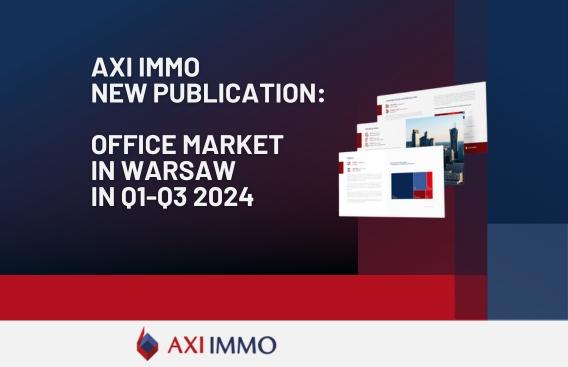Warsaw office market makes strong comeback with new projects and high tenant demand
The Warsaw office market is regaining momentum as developer activity rises, with over 70,000 sq m of new office space delivered by September 2024 and around 280,000 sq m under construction. According to AXI IMMO’s latest report, take-up remained stable at 490,000 sq m in the first three quarters, indicating consistent demand for office space in the capital.
Since January, 76% of new office completions, totaling 6.24 million sq m, were concentrated in Warsaw’s central zones. Major projects completed include the modernized Saski Crescent (15,500 sq m by CA Immo) and Vibe A (15,000 sq m by Ghelamco). The Daszyńskiego Roundabout area has emerged as Warsaw’s largest office hub, with 1.15 million sq m, representing 18% of the city’s total office stock.
Emilia Trofimiuk, Research Manager, Research Department, AXI IMMO, comments: "On the Warsaw office market, we are seeing a gradual return of developers to somewhat more activity. Developers are initiating new investments, emphasising the city's centre zones. The Centre-West office subzone, near Daszyńskiego Roundabout, has 1.15m sq m of existing space, accounting for about 18% of the capital's total office stock. In turn, the whole Warsaw office market has 15% more new supply under construction than last year, showing a steady recovery of developer activity and additional market expansion in the future years.”
Developer activity has increased by 15% year-on-year, with 82% of new stock under development in central zones. Key projects include The Bridge (47,000 sq m by Ghelamco), Upper One (35,900 sq m by Strabag), and V Tower (32,700 sq m by Cornerstone), all set to boost Warsaw’s office landscape by 2025.
Tenant demand remains strong, with sectors like banking, insurance, IT, and business services leading office leases. Major transactions include Santander Bank’s move to The Bridge in the Centre-West zone, securing 24,500 sq m in Q3 2024.
Vacancy rates dropped slightly to 10.7%, while rental rates in central areas held steady between EUR 19 and EUR 27/sq m/month. AXI IMMO notes a trend toward longer lease terms, with companies increasingly opting for well-located, ESG-compliant offices that support hybrid work models and feature green amenities.
Bartosz Oleksak, Associate Director, Office Department, AXI IMMO, said: "Since the beginning of the year, tenants from the banking, insurance, IT, business services, and manufacturing sectors have been the most active in the Warsaw office market. According to observed trends, client relocations from neighbouring office zones and subzones to the region of Daszyńskiego Roundabout continue to be significant. These are demonstrated by the largest transaction in Q3 2024. Santander Bank will relocate from the Central Business District zone to The Bridge building in the Centre-West zone, occupying a 24,500 sq m space under a pre-let agreement. AXI IMMO represented a customer that relocated from Mokotów-Służewiec to a new office space near Rondo Daszyńskiego, measuring roughly 1,300 sq m."
Jakub Potocki, Associate Director, Office Department, AXI IMMO, explains: “'We are witnessing a trend towards lengthening the duration of new leases, with 7-year leases becoming more common. Following the pandemic, corporations are attempting to maximise their office space by shifting to more desirable locations and altering workplaces to satisfy the demands of employees in a hybrid model. The minimal cost of completing the shell and core space stays about EUR 800-900 per sq m. In addition, the capital's office sector is experiencing the repositioning and refitting of older B-class office buildings and the conversion of purpose to residential. Many instances of this can be seen today in the Służewiec district, among others. Another tendency is the destruction of older office buildings to use the available land to develop contemporary office structures that meet current market criteria. Replacing the destroyed Atrium International office building with the newly planned Upper One project is one example of such a procedure in which the office function will be maintained. The new buildings continue the ESG trend by providing additional green space and community amenities. Office buildings are also implementing various technological innovations to save energy expenditures.”
Author: AXI IMMO









